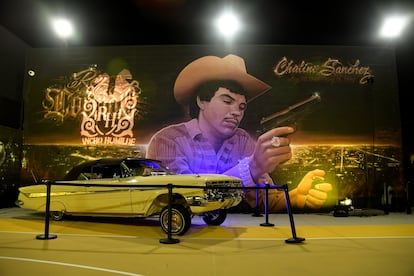A new chapter in the Latin boom: Mexican music takes over from reggaeton
Relegated for decades by class prejudices, the regional music of Mexico is now considered cool and fashionable, with emerging young artists sweeping the global charts as they reinvent their traditions for a new generation of listeners

Less than a year ago, hardly anyone had heard of Peso Pluma beyond the bars of his native state of Jalisco, in Mexico. Today, this slender young Mexican with an Al Capone tattoo on his arm and a bowl cut is one of Jimmy Fallon’s star guests, has the blessing of star producer Bizarrap and has more visits than Bad Bunny, the reggaeton superstar who last April joined the Chicanos of Grupo Frontera to sing a cumbia grupera – a genre that Christian Nodal, a mariachi with face tattoos who plays sold-out concerts in Europe and the Americas, knows well. Trumpets, guitars, accordions. The headphones of millions resonate with the rhythms of regional Mexican music, a booming genre that is surpassing reggaeton on the global charts.
Mexican music is choral. Mariachi, banda or norteño are different genres, but they are usually bundled under the same label: Mexican regional. Although it has always had its audience – especially among Mexican immigrants in the US – it is now becoming established globally, in large part due to the success of the corridos tumbados, a mix of the traditional corridos — episodes of daily life narrated as epic tales — with urban genres like rap and reggaeton. Peso Pluma is the current sensation, but the father of the movement is 22-year-old Natanael Cano: his 2019 album Corridos Tumbados spearheaded the trend, which is now sweeping international catalogues. At the time of publication of this article, there were five of these songs in Spotify’s Global Top 50 playlist.
Relegated by class prejudices for decades, Mexican music has now become cool and fashionable; a similar journey to that of reggaeton, which a few years ago opened the doors of Latin American music to the mass public. “We already saw it with Rosalía and J Balvin. Ibero-America is a muscle. It is very strong in terms of consumption and it’s aligned with a large region, with a single language. Sometimes even Italy joins us in this crusade. Miley Cyrus and Taylor Swift are still on the charts, but they are like traces of the last decade,” says Uriel Waizel, lead editor at Spotify in Mexico. However, although we are entering a new era, he points out that this phenomenon is not here to replace reggaeton. “There was a great shift regarding the high consumption of reggaeton, which is still there and will continue to be there, but the audience has turned to these new idols of Mexican music.”
A smile of disbelief
It is April, 2023. Peso Pluma is singing on the stage of the Toyota Arena in Ontario, California. At one point he falls silent with a half-smile of disbelief on his face. It is hard to fathom that 11,000 people are all singing one of his songs, Por las noches. In little more than a year, Hassan Kabande (his real name) has become the greatest exponent of the corridos tumbados and a musical phenomenon. Today he surpasses the iconic Puerto Rican singer Bad Bunny in web searches, and has remained at the top of important lists such as Spotify’s and the Billboard Hot 100 for weeks with Ella baila sola, a collaborative song with Eslabón Armado. The online advertising tool Google Ads is more skeptical than the web searches: the platform shows that Peso Pluma has an average of 550,000 searches, behind Bad Bunny’s 673,000. Still, the trend is nothing short of impressive, with an increase of 75.461% in the last year.
But that is hardly the only global sensation of Mexican music. The Chicanos of Grupo Frontera have remained on the top spots in recent weeks thanks to Un x100to, the Mexican-style cumbia grupera they recorded with Bad Bunny. In April, the band played three songs with the Puerto Rican on the main stage of Coachella, the most important festival in the US, which a year earlier had featured Grupo Firme, another band that is succeeding with norteño music. The father of mariacheño, Christian Nodal, has also resonated strongly on the international scene, recently becoming the first Mexican to sell out a date at the iconic Wizink Center in Madrid, Spain. Mexican music expands through its ramifications.

Producer Edgar Barrera, one of the architects of the success of the Mexican regional music, explains that he has updated certain genres that have been very popular in Ibero-America. One example he mentions is the song he composed with Nodal, No te contaron mal. “People began to say that we were disrespecting the genre, the culture. I saw it differently. If we want to bring back the mariachi, we have to do it by speaking to the new generations, and speaking the way we speak. I took the poetry out of the lyrics and made them real,” says the American-born composer, who was raised with the culture of the border. Barrera has won 18 Latin Grammys and one Grammy thanks to his flexibility between genres. He recently composed Un x100to for Grupo Frontera and Bad Bunny. He has also done regional songs for Nodal, Gera X and Los Plebes del Rancho, to name a few, as well as pop and reggaeton for Maluma, Camila Cabello, Ariana Grande and Jennifer Lopez, among others.
“We have something stronger and dirtier, like Peso Pluma, but we also have Grupo Frontera. The scale is very well balanced and there is a bit of everything. You can choose one thing or the other, but in the end everything is based on Mexico’s musical history. There are many ways to sing regional Mexican music,” explains Teresa Aguilera, a Billboard journalist with a long career focused on Mexican music. With a population of approximately 127 million people, the country is a key territory to lead the market. Regional music, previously frowned upon or limited to the lower classes, has transcended the prejudice in recent years, penetrating all strata; another point in common with reggaeton.
Looking North
The Spotify executive points out that Mexicans have always kept an eye on the United States, their neighbor to the north; a border influence that has produced some big names, which are now recognized as the predecessors of this new boom. Sitting smartly dressed in suits in a Mexico City hotel, the five members of Los Tigres del Norte, veterans from the northern state of Sinaloa, explain: “At that time [in the 1970s, their early days] we listened to a pioneering group called Los Alegres de Terán. But when we came to the United States, country music also became a big influence. We particularly listened to Johnny Cash, because he sang and spoke in his songs. We started to make music like that, but in Spanish,” says Hernán Hernández, one of the members of this historic band.
With the arrival of Los Tigres del Norte, everything changed. They popularized a song called Contrabando y traición (1974) in which they told a fictitious story about drugs and trafficking, thus becoming part of the pioneers of the narcocorrido, a highly polemic genre that spread throughout the entire country. Afterwards, Los Tigres del Norte took their music to another level, playing more regional styles and diversifying the topics they sang about.
“New artists also understand music as an identity, something that goes hand in hand with things we’ve experienced. Mixing with cultures like the American is part of the growth of music, it has to happen, and I’m glad it happened. If not, who knows in what year Mexican music would have been resurrected,” adds Jorge Hernández, the leader of Los Tigres del Norte. The new artists have been able to reinvent the classic rhythms of their predecessors while mixing them with the American music of their time, the urban genre.

A stronghold in Los Angeles
One of the centers of power of this new musical boom is located in Paramount, California, a small city of 55,000 inhabitants southeast of Los Angeles that is home to the headquarters of Rancho Humilde, the company that launched Fuerza Regida, Natanael Cano and Junior H, among others. The epicenter of the corrido tumbado opened in style last May with the presence of several artists and a nod to the roots that built this empire with one foot in Mexico and the other in the US. In the place there is a mural of Los Angeles with the gothic lettering that is usually associated with Chicanos, as well as a large mural depicting the singer Chalino Sánchez, one of the predecessors of the internationalization of the corrido.
“When I first heard Chalino’s music, it became part of my soul,” Jaime Alejandro Humilde – better known as Jimmy Humilde – the son of Mexican immigrants who left the state of Michoacan for California in the 1980s, has said in interviews. At home, they used to listen to Vicente Fernández, cumbias and Tejano music. His world changed when he heard Sánchez, an emblematic composer and an influential figure for Mexican-Americans. Chalino was murdered in Culiacan, Sinaloa, in May 1992; the Humilde center is located in what used to be Chalino’s office and store, where he sold pagers.
Rancho Humilde was founded in 2008, but success would not come until nine years later, in 2017, with De periódico un gallito, a corrido by LEGADO 7 about a young man with no future who starts selling drugs on the streets of Los Angeles. That was familiar territory for Jimmy Humilde; that of the amoral world of the recruits of the urban gangs that populate hip hop. That was one of the favorite genres of the company’s founder, who grew up in the Venice neighborhood of LA. His favorite artists included the New Yorkers LL Cool J and EPMD.
Thus, Rancho Humilde combined the rhythms of various Mexican genres with the sounds and narratives of rap and hip hop. The formula turned out to be very popular: so far, the company has placed six songs on the Billboard Hot 100 chart. Five of them were there last month. The artists of the Humilde factory have even had the same gestures as rappers when they succeed; with his first royalty check, Natanael Cano bought his mother a house.
The entrepreneurs bet on YouTube, the most used platform to consume audio in the world, to conquer their audience. The presence of Rancho Humilde’s artists on radio and television had been very limited; Bebé dame, by Fuerza Regida, a hit released at the end of 2022, was the first to be played play on American radio. Social media, where they have 3.5 million followers, is their great business marketing tool.
As his label’s executive, Humilde is also betting on a pragmatic strategy, avoiding long-term agreements with record labels, instead opting for individual deals with different companies: Warner, Sony and Universal. This has allowed his artists to gain global exposure while remaining independent.
A conversation between neighbors
In addition to the music, the dialogue with the US has revolved around aesthetics and identity. In the Los Angeles of the 1980s, the cholo movement began to grow, a manifestation of young Mexican migrants (or children of migrants) who were looking for some sort of halfway identity between the country of origin and the destination country. In the tough neighborhoods of the Los Angeles periphery, a conversation took place between gangsta rap and Mexican corridos, between Black and Mexican culture. The cholos kept an aesthetic marked by bandanas, shirts buttoned only at the neck, baggy pants and branded high-top sneakers.
The conversation continues today with the same two elements of the original mix. New Mexican artists wear caps and sneakers (also maintaining the essence of hats and boots, in cases like Grupo Frontera). They try to convey a sense of luxury and status through expensive clothes, powerful cars and even guns, an aesthetic that is associated with drug trafficking. The youngest consumers of the urban variants, such as corrido tumbado, base their style on hair gradients, baseball jackets, branded T-shirts and sneakers.
“It would seem that, as happens with many things in Mexico, they first have to go abroad in order to be recognized and then valued. It could be [movie director] Guillermo del Toro or anything, it happens in film, in gastronomy... It helps a lot that this culture [that of regional music] has one foot set in California or Texas, because then it becomes something cool, aspirational. Our way of working is also interesting, because we are between the United States and Latin America. Corporations sometimes divide by markets, and this is forcing us to see Mexican music as a third country, a bicultural, binational collaboration,” states Waizel.
Narcoculture and counterculture
May of this year. Natanael Cano sings on the stage of the iconic Auditorio Nacional, the most important venue in Mexico City. His dancers come out with fake guns, emulating gunshots and a drug deal. The controversy regarding the references to drug trafficking has constantly surrounded the corridos tumbados, with allusions to Joaquín Guzmán Loera (aka El Chapo), his hit men and more. In interviews, some of these artists have admitted that they do these types of songs “on commission,” a common practice in the corrido genre. An example of this was another of the Mexican pioneers, Chalino Sánchez, who also focused on the border, singing the stories of criminals. He ended up murdered.
The artists of the Mexican urban scene started out with independent record companies or with their own labels, staying away from the big commercial firms – another similarity, for example, with the success of Bad Bunny, who remains faithful to the Puerto Rican independent labels. “They are absolutely countercultural and I would love to see how the American culture, in search of audiences and markets, assimilates these cultures, also to normalize them. I would love to see Gen Z television series, like Euphoria, with tumbado characters,” reflects Waizel.

That oft-repeated journey from the fringes to the center has already begun. The new banda, norteño and mariachi artists are aware of the importance of social networks like TikTok – the one with the most Gen Z users – and they have taken advantage of them. “I think TikTok and Instagram have had a lot to do with it. It’s essential to understand the numbers we are seeing right now,” said Peso Pluma to EL PAÍS in a recent interview.
Sign up for our weekly newsletter to get more English-language news coverage from EL PAÍS USA Edition
Tu suscripción se está usando en otro dispositivo
¿Quieres añadir otro usuario a tu suscripción?
Si continúas leyendo en este dispositivo, no se podrá leer en el otro.
FlechaTu suscripción se está usando en otro dispositivo y solo puedes acceder a EL PAÍS desde un dispositivo a la vez.
Si quieres compartir tu cuenta, cambia tu suscripción a la modalidad Premium, así podrás añadir otro usuario. Cada uno accederá con su propia cuenta de email, lo que os permitirá personalizar vuestra experiencia en EL PAÍS.
¿Tienes una suscripción de empresa? Accede aquí para contratar más cuentas.
En el caso de no saber quién está usando tu cuenta, te recomendamos cambiar tu contraseña aquí.
Si decides continuar compartiendo tu cuenta, este mensaje se mostrará en tu dispositivo y en el de la otra persona que está usando tu cuenta de forma indefinida, afectando a tu experiencia de lectura. Puedes consultar aquí los términos y condiciones de la suscripción digital.
More information
Últimas noticias
There is as much life left to discover on planet Earth as that which is already known
Dozens presumed dead, around 100 injured in fire at Swiss Alps bar during New Year’s celebration
Is porn for women different from conventional porn? We spoke to those who make it
Cartagena de Indias is sinking: What can the city do to mitigate it?
Most viewed
- David King, chemist: ‘There are scientists studying how to cool the planet; nobody should stop these experiments from happening’
- Reinhard Genzel, Nobel laureate in physics: ‘One-minute videos will never give you the truth’
- Oona Chaplin: ‘I told James Cameron that I was living in a treehouse and starting a permaculture project with a friend’
- Sinaloa Cartel war is taking its toll on Los Chapitos
- The Interoceanic Train, the Mexican alternative to the Panama Canal










































